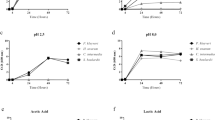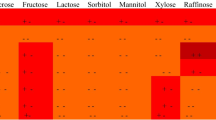Abstract
Yeasts have been important components of spontaneous fermentations in food and beverage processing for millennia. More recently, the potential of utilising antagonistic yeasts, e.g. Pichia anomala and Candida spp., for post-harvest biological control of spoilage fungi during storage of plant-derived produce (‘biopreservation’) has been clearly demonstrated. Although some yeast species are among the safest microorganisms known, several have been reported in opportunistic infections in humans, including P. anomala and bakers’ yeast, Saccharomyces cerevisiae. More research is needed about the dominant pathogenicity and virulence factors in opportunistic yeasts, and whether increased utilisation of biopreservative yeasts in general could contribute to an increased prevalence of yeast infections. The regulatory situation for yeasts used in post-harvest biocontrol is complex and the few products that have reached the market are mainly registered as biological pesticides. The qualified presumption of safety (QPS) approach to safety assessments of microorganisms intentionally added to food or feed, recently launched by the European Food Safety Authority, can lead to more efficient evaluations of new products containing microbial species with a sufficient body of knowledge or long-term experience on their safety. P. anomala is one of several yeast species that have been given QPS status, although the status is restricted to use of this yeast for enzyme and metabolite production purposes. With regard to authorisation of new biopreservative yeasts, we recommend that the possibility to regulate microorganisms for food biopreservation as food additives be considered.
Similar content being viewed by others
References
Anonymous (2010) Community register of feed additives pursuant to regulation (EC) No 1831/2003. Appendices 3 & 4, Annex: list of additives. Released 23 Sept 2010
Aragao PA, Oshiro ICV, Manrique EI, Gomes CC, Matsuo LL, Leone C, Moretti-Branchini ML, Levin AS (2001) Pichia anomala outbreak in a nursery: exogenous source? Pediatr Infect Dis J 20:843–848
Chamba JF, Jamet E (2008) Introduction—contribution to the safety assessment of technological microflora found in fermented dairy products. Int J Food Microbiol 126:263–266
Danish Veterinary and Food Administration (2010) Liste over anmeldte mikrobielle kulturer (in Danish). http://www.foedevarestyrelsen.dk/NR/rdonlyres/1EBB2EA6-3A71-4317-BF36-50314F8C77D7/0/Kulturregister_4.pdf. Accessed 29 Oct 2010
de Hoog GS (1996) Risk assessment of fungi reported from humans and animals. Mycoses 39:407–417
Druvefors U, Jonsson N, Boysen ME, Schnürer J (2002) Efficacy of the biocontrol yeast Pichia anomala during long-term storage of moist feed grain under different oxygen and carbon dioxide regimens. FEMS Yeast Res 2:389–394
EFSA (2007) Introduction of a Qualified Presumption of Safety (QPS) approach for assessment of selected microorganisms referred to EFSA. EFSA J 587:1–16
EFSA (2008) The maintenance of the list of QPS microorganisms intentionally added to food or feed. EFSA J 923:1–48
EFSA (2009) Scientific opinion on the maintenance of the list of QPS microorganisms intentionally added to food or feed (2009 update). EFSA J 7(12):1431
EU (1997) Regulation (EC) No 258/97 of the European Parliament and of the Council concerning novel foods and novel food ingredients
EU (2000) Directive 2000/54/EC on the protection of workers from risks related to exposure to biological agents at work
EU (2001) Commission Directive 2001/36/EC concerning the placing of plant protection products on the market
EU (2003) Regulation (EC) No 1831/2003 on additives for use in animal nutrition
EU (2005) Council Directive 2005/25/EC amending Annex VI to Directive 91/414/EEC as regards plant protection products containing micro-organisms
EU (2007) Commission Decision 2007/380/EC recognising in principle the completeness of the dossiers submitted for detailed examination in view of the possible inclusion of Candida oleophila strain O in Annex I to Council Directive 91/414/EEC
EU (2008a) Regulation (EC) No 1333/2008 on food additives
EU (2008b) Regulation (EC) No 1331/2008 establishing a common authorisation procedure for food additives, food enzymes and food flavourings
Fleet GH, Balia R (2006) The public health and probiotic significance of yeasts in foods and beverages. In: Querol A, Fleet GH (eds) The yeast handbook: yeasts in food and beverages. Springer-Verlag, Berlin, pp 381–397
Garcia-Martos P, Hernandez-Molina JM, Galan F, Ruiz-Henestrosa JR, Garcia-Agudo R, Palomo MJ, Mira J (1999) Isolation of Hanseniaspora uvarum (Kloeckera apiculata) in humans. Mycopathology 144:73–75
Giobbe S, Marceddu S, Scherm B, Zara G, Mazzarello VL, Budroni M, Migheli Q (2007) The strange case of a biofilm-forming strain of Pichia fermentans, which controls Monilinia brown rot on apple but is pathogenic on peach fruit. FEMS Yeast Res 7:1389–1398
Haron E, Anaisse E, Dumphy F, McCredie K, Fainstein V (1988) Hansenula anomala fungemia. Rev Infect Dis 10:1182–1186
Haushild R, Speiser B (2007) A comparison of legislation and current practice regarding evaluation and registration of plant protection products based on micro-organisms, plant extracts and pheromones in EU, USA, Canada and Australia. WP 2 of the EU project REBECA. http://www.rebeca-net.de/?p=370. Accessed 27 Oct 2010
IDF (2002a) Food microorganisms—health benefits, safety evaluation and strains with documented history of use in foods. Bull IDF 377:4–9
IDF (2002b) Inventory of microorganisms with a documented history of use in food. Bull IDF 377:10–19
Jacques N, Casaregola S (2008) Safety assessment of dairy microorganisms: the hemiascomycetous yeasts. Int J Food Microbiol 126:321–326
Jensen DP, Smith DL (1976) Fever of unknown origin secondary to brewer’s yeast ingestion. Arch Intern Med 136:332–333
Jijakli MH, Lepoivre P (1998) Characterization of an exo-beta-1, 3-glucanase produced by Pichia anomala strain K, antagonist of Botrytis cinerea on apples. Phytopathology 88:335–343
Kurtzman CP, Robnett CJ, Basehoar-Powers E (2008) Relationships among species of Pichia, Issatchenkia and Williopsis determined from multigene phylogenetic analysis and the proposal of Barnettozyma gen. nov., Lindnera gen. nov. and Wickerhamomyces gen. nov. FEMS Yeast Res 8:939–954
Lachance MA (2003) The Phaff school of yeast ecology. Int Microbiol 6:163–167
Mattia A, Merker R (2008) Regulation of probiotic substances as ingredients in foods: premarket approval or “Generally Recognized as Safe” notification. Clin Infect Dis 46:S115–S118
Moschini M, Gallo A, Piva G, Masoero F (2008) The effects of rumen fluid on the in vitro aflatoxin binding capacity of different sequestering agents and in vivo release of the sequestered toxin. Animal Feed Sci Technol 147:292–309
Murphy A, Kavanagh K (1999) Emergence of Saccharomyces cerevisiae as a human pathogen: implications for biotechnology. Enzyme Microb Technol 25:551–557
Nyirjesy P, Vazquez JA, Ufberg DD, Sobel JD, Boikov DA, Buckley HR (1995) Saccharomyces Cerevisiae vaginitis—transmission from yeast used in baking. Obstet Gynecol 86:326–329
Park KA, Ahn K, Chung ES, Chung TY (2008) Pichia anomala fungal keratitis. Cornea 27:619–620
Passoth V, Fredlund E, Druvefors UA, Schnürer J (2006) Biotechnology, physiology and genetics of the yeast Pichia anomala. FEMS Yeast Res 6:3–13
US EPA (2009) Biopesticides Registration Action Document (BRAD), Candida oleophila Strain O. U.S. Environmental Protection Agency, Office of Pesticide Programs, Biopesticides and Pollution Prevention Division. http://www.epa.gov/pesticides/biopesticides/product_lists/new_ai_2009.html. Accessed 27 Oct 2010
Walker GM (2010) Pichia anomala: cell physiology and biotechnology relative to other yeasts. Antonie van Leeuwenhoek. doi:10.1007/s10482-010-9491-8
Wessels S, Axelsson L, Hansen EB, De Vuyst L, Laulund S, Lahteenmaki L, Lindgren S, Mollet B, Salminen S, von Wright A (2004) The lactic acid bacteria, the food chain, and their regulation. Trends Food Sci Technol 15:498–505
Acknowledgments
This study was carried out as part of the research programme Domestication of Microorganisms (DOM, http://www.mistra.org/dom), funded by Mistra (Foundation for Strategic Environmental Research). We are grateful to Svend Laulund, Chr. Hansen A/S, Denmark, for advice concerning the regulation of microbial food cultures.
Author information
Authors and Affiliations
Corresponding author
Rights and permissions
About this article
Cite this article
Sundh, I., Melin, P. Safety and regulation of yeasts used for biocontrol or biopreservation in the food or feed chain. Antonie van Leeuwenhoek 99, 113–119 (2011). https://doi.org/10.1007/s10482-010-9528-z
Received:
Accepted:
Published:
Issue Date:
DOI: https://doi.org/10.1007/s10482-010-9528-z




